| Thurahalli Forest | |
|---|---|
.jpg.webp) | |
| Map | |
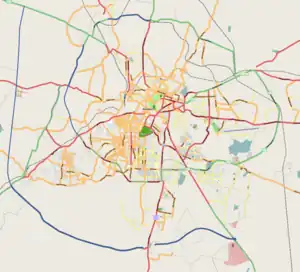 | |
| Geography | |
| Location | Bengaluru, Karnataka, India |
| Coordinates | 12°52′54″N 77°31′30″E / 12.8816831°N 77.5249823°E |
| Elevation | 888 metres |
| Area | 590 acres |
| Administration | |
| Status | protected, endangered |
| Governing body | Karnataka Forest Department |
| Ecology | |
| Ecosystem(s) | India |
| Disturbance | forest fires, garbage dumping |
| Dominant tree species | Eucalyptus |
The Thurahalli Forest or Thurahalli Park is a dry and deciduous forest. It is located about 20 km from Bengaluru off Kanakapura Road. It is 13 km from Banashankari and can be overseen from the NICE road. Entry inside the park has been banned for vehicles, however, it has become a hot spot for cyclists.
It has a nice view and a small Shani temple on top of a rocky hill. As of today, Thurahalli forest is said to be Bengaluru's only surviving forest.[1]
Rocks in the forest provide one of the few outdoor bouldering opportunities to the cities residents and have multiple established routes.
Wildlife
Flora
The majority of trees are eucalyptus.[2] During August, the orchids (Habenaria roxburghii) bloom, giving a brilliant white colour to contrast the green of the forest. The rocky terrains are great for lianas, the most common being Opilia amentacea. They bloom during the summer. These are mostly located in the Northern edge of the forest, surrounded by figs (Ficus tinctoria), nerale-mara (Syzygium cumini) and rocks. The most common herb is the Byttneria herbacea. It blooms throughout the year. Its flowers attract many beetles. Legumes, specifically Indigofera karnatakana are found here. Ixora pavetta bloom during the summer. They have an intoxicating fragrance.[3]
Fauna
Many animals can be spotted, including spotted deer, wild boar,[4] hares, jackals, lizards, mongooses, etc. Turahalli is also famous for its bird population, which includes rare jungle birds like Eagle-owl,[5] Sirkeer malkoha,[6] common flameback woodpecker, and blue rock thrush,[7] in addition to relatively common jungle birds like peafowl,[8] Asian green bee-eater, paradise flycatcher, white-throated fantail flycatcher,[9] jungle babbler, rufous treepie, black drongo, white-breasted kingfisher, pond heron, spotted dove, purple-rumped sunbird, oriental white-eye, barn swallow, red-rumped swallow, small minivet, white-browed bulbul, red-vented bulbul, common iora, oriental magpie robin; birds of the plains like rufous-tailed lark and pied bushchat, in addition to common urban birds like house crows, jungle crows, common mynas, black kites, brahminy kites, blue rock pigeons, Asian koels, and more.[10][2][11]
Activities
Turahalli offers excellent biking trails.[12] It is also among the few places within the city for natural rock climbing in addition to Avathi and Raogodlu.[13] Rocks are granite, with various sizes and shapes. Many climbers practice regularly, in preparation for local or international competitions.[13][14][15][16]
Endangerment
The forest is the last one surviving in Bengaluru. It has slowly been encroached upon. It has also been used as an illegal garbage dump, which has negatively affected the wildlife.[17][18] Frequent fires during the summers, both natural and those caused by locals, have significantly impacted certain species of plants that grow in this forest.[3] The BBMP also opened a sewage treatment plant near the forest.[19] There is also a problem with poaching. Land has also been illegally cleared to grow crops.[13] Over the past few years, efforts have been made by nearby residents to clean up and to prevent further encroachment and dumping of waste in the forest.[20]
Gallery
 View from Turahalli Forest
View from Turahalli Forest Temple near the view-point
Temple near the view-point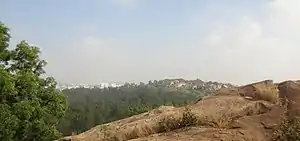 View of city as seen from rock in Turahalli Forest
View of city as seen from rock in Turahalli Forest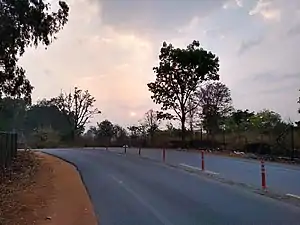 Sunrise
Sunrise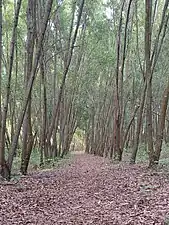 Cycling Trail at Turahalli Forest
Cycling Trail at Turahalli Forest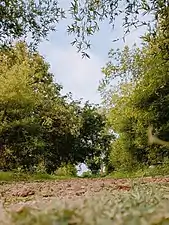 Turahalli forest Cycling Trail
Turahalli forest Cycling Trail
See also
References
- ↑ Mohan, Deepa (28 September 2012). "Thurahalli: Bangalore's last forest standing?". The Alternative. Retrieved 29 June 2018.
- 1 2 "Save Turahalli". Dream Routes. Retrieved 28 June 2018.
- 1 2 Sharma, Anurag (15 August 2016). "Turahalli: an urban forest". JLR Explore. Retrieved 28 June 2018.
- ↑ Govind, Ranjani (23 April 2019). "Water, home-delivered at Turahalli forest". The Hindu. ISSN 0971-751X. Retrieved 5 August 2019.
- ↑ "Turahalli special". www.indianaturewatch.net. Retrieved 5 August 2019.
- ↑ "Sirkeer malkoha". www.indianaturewatch.net. Retrieved 5 August 2019.
- ↑ "Blue Rock Thrush ( Female )". www.indianaturewatch.net. Retrieved 5 August 2019.
- ↑ "Peacock | Habitat shot". www.indianaturewatch.net. Retrieved 5 August 2019.
- ↑ "White-throated Fantail". www.indianaturewatch.net. Retrieved 5 August 2019.
- ↑ "The Turahalli Trip". Deponti to the world. 10 March 2008. Retrieved 5 August 2019.
- ↑ "Turahalli Forest For A Spot Of Hiking and Cycling". LBB. Retrieved 28 June 2018.
- ↑ "10 best cycling routes in the city". Bangalore Mirror Bureau. Bangalore Mirror. 3 July 2018. Retrieved 28 June 2018.
- 1 2 3 "Save Turahalli - Bouldering". Dream Routes. Retrieved 28 June 2018.
- ↑ "Rock Climbing in Ravugodlu, Bangalore Area and Southern Karnataka".
- ↑ "Outdoor Adventure Activities in Bangalore | Weekend Events in Bangalore | Avathi". www.avathi.com.
- ↑ "Rock Climbing in Avathi, Bangalore Area and Southern Karnataka".
- ↑ Satyanarayan, Shwetha (21 October 2015). "New Landfill in Turahalli: Another Mandur in making?". Deccan Chronicle. Retrieved 28 June 2018.
- ↑ Mohan, Deepa (16 September 2012). "Turahalli: Developments further to the Habba". Citizen Matters. Retrieved 28 June 2018.
- ↑ Baradhwaj, K. V. Aditya (28 March 2016). "Setback to BBMP in dealing with garbage crisis". The Hindu. Retrieved 29 June 2018.
- ↑ Kaushik, Tushar (18 February 2018). "Karnataka: Women Power Saves Forest Cover". The New Indian Express. Retrieved 28 June 2018.